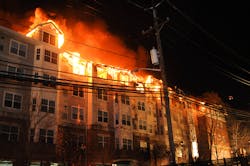Salka: Lightweight Construction is Bad For Everyone
If you live in the New York/New Jersey metropolitan area you are surely aware of the gigantic fire that occurred on the shores of the Hudson River in Edgewater.
Let's start with lightweight wood construction (LWWC). We all know it sucks! Let's cut right to the facts. LWWC is just that, lightweight wood components that are assembled in such a way that they hold the weight or load that they need to carry. They only do this when they are not on fire, not assembled improperly or not damaged by plumbers, carpenters and electricians who damage them to install wiring, pipes or other components.
We in the fire service spend lots of time talking about how dangerous LWWC is to us and we are right. But this unbelievable fire in Edgewater showed us just how dangerous this type of construction is to our citizenry and our communities. Once these building get going there is little a fire department can do to stop it. Additionally, if the fire gets large enough other buildings in the neighborhood are also in danger.
In case you didn’t know, this building was sprinklered. Yes, it originally burned down years ago when it was under construction and after the fire they rebuilt it with sprinklers. So how did it burn down this time? The sprinklers are in the living areas. In the apartments and rooms where people and furnishings are. They generally aren’t in the walls or inside the ceilings or up in the cockloft or attic. And that is where this fire started and raged, before spreading into all of the other areas and components of the structure. Workers with a torch sparked the fire and it went downhill from there.
How does a fire of such magnitude develop in a sprinklered building? Very easily. As I already mentioned the sprinklers are generally installed to protect the living areas, not the insides of the walls and above the ceilings. Add to that the lightweight wooden construction and you have a disaster in the making.
Now, an article in the New York Times left my head spinning. In the article it stated, “officials said the sprinkler system had functioned properly - it is intended not to douse the fire but to allow residents time to escape.” Really? I have a newsflash for the “officials” who made that statement. Sprinklers deliver water and water is used to extinguish fires. Sprinklers are designed to put the fire out in its early incipient stages. The sprinklers in this fire didn’t do their job because the fire was concealed in the building's vertical and horizontal voids.
Lightweight wooden construction does not play well with fire. I have been to hundreds of serious fires in multi-story residential buildings constructed with dimensional lumber rather that lightweight wooden construction and very few burned down. The substantial lumber and compartmentation limited the fire spread and didn’t allow the fire to spread to every area of the building.
Next time someone suggests building a structure of LWWC you need to remember this fire in Edgewater. Even fire sprinklers could not save the building.
